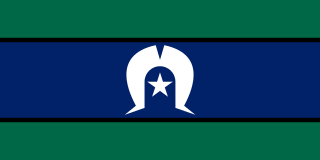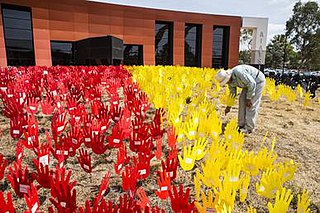Related Research Articles
The demography of Australia covers basic statistics, most populous cities, ethnicity and religion. The population of Australia is estimated to be 25,644,400 as of 10 August 2020. Australia is the 52nd most populous country in the world and the most populous Oceanian country. Its population is concentrated mainly in urban areas and is expected to exceed 28 million by 2030.

The Torres Strait Islands are a group of at least 274 small islands in Torres Strait, the waterway separating far northern continental Australia's Cape York Peninsula and the island of New Guinea. They span an area of 48,000 km2 (19,000 sq mi), but their total land area is 566 km2 (219 sq mi).

Torres Strait Islanders are the Indigenous peoples of the Torres Strait Islands, which are part of the state of Queensland, Australia. Ethnically distinct from the Aboriginal people of the rest of Australia, they are often grouped with them as Indigenous Australians. Today there are many more Torres Strait Islander people living in mainland Australia than on the Islands.

The Australian Aboriginal Flag represents Aboriginal Australians. It is one of the officially proclaimed flags of Australia, and holds special legal and political status. It is often flown together with the national flag and with the Torres Strait Islander Flag, which is also an officially proclaimed flag.

The Australian Institute of Aboriginal and Torres Strait Islander Studies (AIATSIS), established as the Australian Institute of Aboriginal Studies (AIAS) in 1964, is an independent Australian Government statutory authority. It is a collecting, publishing and research institute and is considered to be Australia's premier resource for information about the cultures and societies of Aboriginal and Torres Strait Islander peoples. The Institute is a leader in ethical research and the handling of culturally sensitive material and holds in its collections many unique and irreplaceable items of cultural, historical and spiritual significance. The collection at AIATSIS has been built through over 50 years of research and engagement with Aboriginal and Torres Strait Islander communities and is now a source of language and culture revitalisation, native title research and family and community history. AIATSIS is located on Acton Peninsula in Canberra, Australian Capital Territory.

Aboriginal Australians is a western term for the people who are from the Australian mainland and many of its islands, such as Tasmania, Fraser Island, Hinchinbrook Island, the Tiwi Islands, and Groote Eylandt, but excluding the Torres Strait Islands.

Aboriginal deaths in custody is a political and social issue in Australia. It rose in prominence in the early 1980s, with Aboriginal activists campaigning following the death of 16-year old John Peter Pat in 1983. Subsequent deaths in custody, considered suspicious by families of the deceased, culminated in the 1987 Royal Commission into Aboriginal Deaths in Custody (RCIADIC).
Australia has no official language. English has been entrenched as the de facto national language since European settlement. Australian English is a major variety of the language with a distinctive pronunciation and lexicon, and differs slightly from other varieties of English in grammar and spelling. General Australian serves as the standard dialect.
Mapoon is a coastal town in the Aboriginal Shire of Mapoon and a locality split between the Aboriginal Shire of Mapoon and the Shire of Cook in Queensland, Australia.

Australians, colloquially referred to as "Aussies", are people associated with the country of Australia, usually holding Australian citizenship.
Indigenous Australians are people with familial heritage to groups that lived in Australia before British colonisation. They include the Aboriginal and Torres Strait Islander peoples of Australia. The term Aboriginal and Torres Strait Islander people, or the person's specific cultural group, is often preferred, though the terms First Nations of Australia, First Peoples of Australia and First Australians are also increasingly common.

The Torres Strait Regional Authority (TSRA) is an Australian Government body established in 1994 to administer the Torres Strait Islands. It consists of 20 elected representatives. The primary function of the Authority is to strengthen the economic, social and cultural development of the peoples of the Torres Strait area.
Makinti Napanangka was a Pintupi-speaking Indigenous Australian artist from Australia's Western Desert region. She was referred to posthumously as Kumentje. The term Kumentje was used instead of her personal name as it is customary among many indigenous communities not to refer to the deceased by their original given name for some time after their death. She lived in the communities of Haasts Bluff, Papunya, and later at Kintore, about 50 kilometres (31 mi) north-east of the Lake MacDonald region where she was born, on the border of the Northern Territory and Western Australia.
Linda Yunkata Syddick Napaltjarri is a Pintupi- and Pitjantjatjara- speaking Indigenous artist from Australia's Western Desert region. Her father was killed when she was young; her mother later married Shorty Lungkarta Tjungarrayi, an artist whose work was a significant influence on Linda Syddick's painting.
Indigenous Australians are both convicted of crimes and imprisoned at a disproportionately high rate in Australia, as well as being over-represented as victims of crime. The issue is a complex one, to which federal and state governments as well as Indigenous groups have responded with various analyses and numerous programs and measures. As of September 2019, Aboriginal and Torres Strait Islander prisoners represented 28% of the total adult prisoner population, while accounting for 3.3% of the general population.
Indigenous health in Australia examines health and wellbeing indicators of Indigenous Australians compared with the rest of the population. Statistics indicate that Aboriginal Australians and Torres Strait Islanders are much less healthy than other Australians. Various government strategies have been put into place to try to remediate the problem; there has been some improvement in several areas, but statistics between Indigenous Australians and the rest of the Australian population still show unacceptable levels of difference.
The Closing the Gap framework is an Australian government strategy that aims to reduce disadvantage among Aboriginal and Torres Strait Islander people, based on seven targets. From adoption in 2008, after meetings with the Close the Gap social justice campaign, until 2018, the federal and state and territory governments, worked together via the Council of Australian Governments (COAG) on the framework, with the Department of the Prime Minister and Cabinet producing a report at the end of each year analysing progress on each of its seven targets.
Section 127 of the Constitution of Australia was the final section within Chapter VII, and mandated the exclusion of Aboriginal Australians from population counts conducted for electoral purposes. It came into effect on 1 January 1901 when the founding states federated into the Commonwealth of Australia, and was repealed effective 10 August 1967 following the 1967 referendum.

Lisa Rae Jackson Pulver is an Aboriginal Australian epidemiologist and researcher in the area of Aboriginal health who has been Deputy Vice Chancellor at the University of Sydney since October 2018.
Close the Gap (CTG) is a social justice campaign focused on Indigenous Australians' health, in which peak Aboriginal and Torres Strait Islander and non-Indigenous health bodies, NGOs and human rights organisations work together to achieve health equality in Australia. The Campaign was launched in April 2007. National Close the Gap Day (NCTGD) has been held annually since 2009.
References
- ↑ "National Aboriginal and Torres Strait Islander Social Survey", Australian Bureau of Statistics, accessed 11 November 2010. Archived by WebCite on 11 November 2010.
- ↑ 4714.0 – National Aboriginal and Torres Strait Islander Social Survey, 2008, Australian Bureau of Statistics, 30 October 2009, accessed 11 November 2010. Archived by WebCite on 11 November 2010.